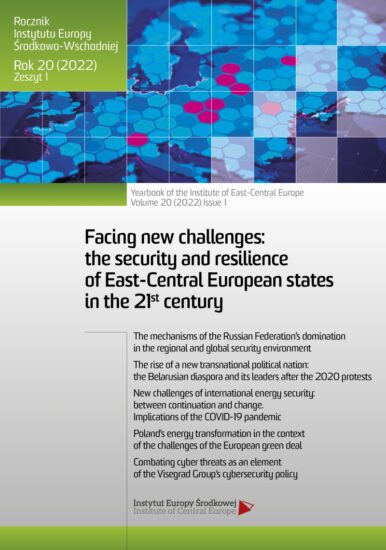Nowe wyzwania międzynarodowego bezpieczeństwa energetycznego: między kontynuacją a zmianą. Implikacje pandemii COVID-19
ORCID: Ewelina Kochanek: 0000-0001-8155-9209
Afiliacja: The University of Szczecin, Poland
Pages: 79-101
Edition: Lublin 2022
DOI: https://doi.org/10.36874/RIESW.2022.1.5
Citation method: E. Kochanek, Poland's energy transformation in the context of the challenges of the European green deal, „Rocznik Instytutu Europy Środkowo-Wschodniej” 20(2022), z. 1, s. 79-101,
DOI: https://doi.org/10.36874/RIESW.2022.1.5.
Keywords: climate and energy policy, energy security, energy transition, European Green Deal, Poland’s energy strategy (PEP2040)
Abstract:
One of the most important socio-economic challenges is the skilful transformation of the economy towards low and zero-emission energy sources. This transformation is ongoing, and Poland, due to its high dependence on coal and high emissions has a challenging task to perform. Hence, the article aims to indicate the activities undertaken by Poland as part of the energy transformation related to the European Green Deal and the impact of energy transformation on the Polish economy. Therefore, the issues discussed include: explaining the principles characterizing the European Green Deal programme, describing the current state of the Polish energy sector, indicating activities that will make Poland a zero-emissions nation, and highlighting the economic implications of this energy transformation at the national level. The analysis shows that the transformation of the domestic energy sector is a long-term, ongoing process. The share of green energy in the national mix is systematically, albeit slowly, growing, and energy sector emissions show a downward trend, although in the current difficult energy situation in Europe, this trend may slow down. Moreover, for systemic and financial reasons it is not possible to quickly replace energy production from coal with other low or zero-emission energy carriers. The study used a critical analysis of the literature and strategic documents on the energy sector, the institutional and legal method, the prognostic method, and inductive inference.
Bibliography:
Bielecki T., Poland agrees to EU climate acceleration, Deutsche Welle, 11 December 2020, https://www.dw.com/pl/klimat-polska-szczyt-ue-55proc/a-55909122 [25.04.2022].
Bocian K., Lewandowski W., Wróbel P., Zielone koło ratunkowe. Dostęp do czystej energii warunkiem konkurencyjności polskiego przemysłu, Warsaw 2022.
BP, BP Statistical Review of World Energy, 2021.
Brauers H., Oei P.-Y., The political economy of coal in Poland: Drivers and barriers for a shift away from fossil fuels, “Energy Policy” 2020, vol. 144.
Budnitza R., Rogner H., Shihab-Eldinc A., Expansion of nuclear power technology to new countries – SMRs, safety culture issues, and the need for an improved international safety regime, “Energy Policy” 2018, vol. 19. European Environment Agency, Climate Change, https://www.eea.europa.eu/pl/themes/climate/about-climate-change.
Derski B., Importujemy coraz więcej prądu i… ratujemy sąsiadów eksportem, Wysokie Napięcie, 21 January 2021, https://wysokienapiecie.pl/35185-importujemy-coraz-wiecej-pradu-ratujemy-sasiadow-eksportem/.
Derski B., Najwyższa w historii produkcja i zużycie energii, Wysokie Napięcie, 15 January 2022, https://wysokienapiecie.pl/44288-najwyzsza-w-historii-produkcja-zuzycie-energii/.
Derski B., Źródła energii w Polsce w 2020: mniej węgla, więcej gazu i OZE, Wysokie Napięcie, 12 February 2021, https://wysokienapiecie.pl/35619-zrodla-energii-w-polsce-w-2020-mniej-wegla-wiecej-gazu-oze/.
Dowiedz się więcej o Funduszach Europejskich, Portal Funduszy Europejskich, 4 June 2021, https://www.funduszeeuropejskie.gov.pl/strony/o-funduszach/fundusze-na-lata-2021-2027/dowiedz-sie-wiecejo-funduszach-europejskich-na-lata-2021-2027/.
Energy transformation: the Polish way to a low-carbon economy, Biznes Alert, 21 November 2019, https://biznesalert.pl/transformacja-energetyczna-energetyka-polska.
European Commission, Commission Staff Working Document Country Report – Poland 2020, Brussels 2020.
Frączyk J., Polska gospodarka ostro ścięła emisję CO2. Osiem krajów za nami, w tym Niemcy i Czechy, Business Insider, 20 June 2022, https://businessinsider.com.pl/gospodarka/emisja-co2-ostro-w-dol-osiem-krajow-za-namiw-tym-niemcy-i-czechy/djj4lcf.
Frankowski J. et al., Employment in hard coal mining in the Upper Silesian Basin, “IBS Research” 2020, no. 1.
Gabryś H., Elektroenergetyka w Polsce 2020, “Energetyka” 2020, no. 8.
Gawlikowska-Fyk A., Borkowski M., How Poland can achieve increased greenhouse gas emission reduction targets by 2030, Energy Forum, 2020.
IEO, Photovoltaic market in Poland 2020, 2020.
Jastrzębska G., Odnawialne źródła energii i pojazdy proekologiczne, Warsaw 2007.
Kasztelanowicz Z., Raport o stanie branży węgla brunatnego w Polsce i w Niemczech wraz z diagnozą działań dla rozwoju tej branży w I połowie XXI wieku, Cracow 2018.
Kochanek E., Evaluation of Energy Transition Scenarios in Poland, “Energies” 2021, vol. 14(19).
Kołodziejski M., Fundusz na rzecz Sprawiedliwej Transformacji, March 2022, https://www.europarl.europa.eu/factsheets/pl/sheet/214/fundusz-na-rzecz-sprawiedliwej-transformacji-fst-.
Księżopolski K., Maśloch G., Time Delay Approach to Renewable Energy in the Visegrad Group, “Energies” 2021, vol. 14.
Kyoto Protocol to the UN Framework Convention on Climate Change, OJ 2005, no. 203.
Lachowicz M., Gacki M., Moskwik K., Paliwa i motory wzrostu gospodarczego, Warsaw 2020.
Landis F., Heindl P., Renewable Energy Targets in the Context of the EU ETS: Whom do They Benefit Exactly, “Discussion Paper” 2016, no. 16.
Lu M., The European Union’s Energy dependency, Visual Capitalist, 22 March 2022, https://www.visualcapitalist.com/visualizing-the-eus-energy-dependency/.
Miętkiewicz R., FSRU terminal on the Gdańsk coast – próba analizy, “Analiza IPE”, nr 1, 2019.
Ministerstwo Klimatu i Środowiska, Polityka Energetyczna Polski 2040, Warsaw 2021.
PGNiG, Sprawozdanie Zarządu z działalności PGNiG SA oraz GK PGNiG na 2020 rok, 2020.
Polskie Sieci Energetyczne S.A., Plan rozwoju w zakresie zaspokojenia obecnego i przyszłego zapotrzebowania na energię elektryczną na lata 2021-2030, Konstancin-Jeziorna 2020.
Rączka J., Transformation of district heating 2030: Small district heating systems, Energy Forum, 2017.
Robaina M., Neves A., Complete decomposition analysis of CO2 emissions intensity in the transport sector in Europe, “Research in Transportation Economics” 2021, vol. 90.
Ruszel M., The significance of the Baltic Sea Region for natural gas supplies to the V4 countries, “Energy Policy” 2020, vol. 146.
Sawicki B., Znaczący wzrost emisji CO2 w Polsce. Winny eksport prądu, energia.rp.pl, 18 May 2022, https://energia.rp.pl/co2/art36322571-znaczacywzrost-emisji-co2-w-polsce-winny-eksport-pradu.
The European Council, the Council of the Economic and Social Committee and the Committee of the Regions, Announcement from the Commission to the European Parliament, European Green Deal, Brussels 2019.
The Ministry of Energy, Draft Conclusions from forecast analyses for the fuel and energy sector – appendix 2. to PEP 2040, 2019.
The Ministry of Energy, National Energy and Climate Plan for 2021-2030, 2019.
Tokarski S., Janikowski J., Kyoto Protocol – Poland ahead of Scandinavia in reducing emissions, “ Polska Energia Tauron” 2010, no. 4.
United Nations, Paris Agreement, 2015.
Urząd Regulacji Energetyki, Raport Krajowy Prezesa Urzędu Regulacji Energetyki 2020, 2020.
Zalewska-Wojtuś K., Kałek P., Amendment of the Energy Law, “Energia Elektryczna” 2020, no. 1.

PDF: Download